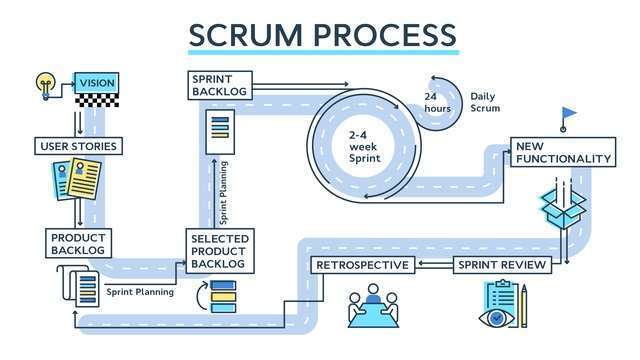When I reflect on the major changes in the world of work, I can’t help thinking how innovation has played a key role, within the creation process of more dynamic working environments, where new possibilities emerged –such as co-working areas, remote work and results-oriented professional freelancing.
In this scenario, certain issues become essential, both for the proper evolution of a project and also for the relationship between contractor and executor. For instance, as regards the debate of remote work flexibility and the readiness to hire a freelancer, I think that this readiness, this agility, goes far beyond –embracing new methods and agility for remote working is a transformative process.
Here is the basis of a strategy based on productivity and sustainability, that companies, freelancers and any other party will benefit from. But before we go any further, let us try to analyze some of these concepts.
What is agility?
Agility is not just a step-by-step project method. So what is it? I would divide this process into two different stages:
- It’s the ability to create and respond swiftly to any market changes so as to follow trends and keep standing in this troubled world.
- It’s the ability to balance flexibility and stability. In a context of uncertainty and distress, success belongs to companies and to those people who can build the changes (even chaos). Changes will disrupt competitors and, to achieve that, the creative process must be associated with innovation in order to develop new products, create new sales channels, segment and customize products and services.
Agility is also linked to temporary flexibility and the abilitty to develop projects from quite a different approach, focusing on performance and results.
Talking about agility means referring to project management –and that takes us to the well-known Scrum Methodology. This is not a standardized process where you follow a bunch of sequential stages to achieve increased productivity resulting in a high quality product that your clients will love.
Instead, Scrum is a framework to help you organize and manage complex assignments such as software development projects.

If we apply this terminology to Workana universe, for instance, we can relate agility to a new way of working –and I mean the benefits that result from the changes on the world of work, the use of new technologies and the creation of new working areas.
And naturally, behind the expansion of these new working methods we’ll find the ever-increasing improvements of mobile devices, the Internet, computers, services in the cloud, etc. Actually, the network or the digital world is becoming more and more like a working site with the resulting increase of people working «in the cloud» or «in the virtual world».
Agile project management is a global movement with principles, methods, check-lists, techniques and tools to help organizations thrive in an ever-increasing volatile, complex and uncertain world, full of ambiguity.
It is essential for the entrepreneur to count on a methodology such as this, since agile work is usually associated to hiring people, processes, to connectivity and technology, to time and place, all of these together, in order to find the most accurate and effective way of working on some task or set of tasks.
Which are the benefits of an agile team?
There are lots advantages to agile teams. Remember that remote work has allowed people to manage work more efficiently, offering a top-quality product within a limited budget. This has to do with the fact that Home Office means the ability to lead with a wide range of topics, client types and projects on a daily basis, providing freelancers with an extra stock of knowledge and cultural background of the utmost value.
Agile teams are well known for their high efficiency on project fulfillment. They usually share a collaborative culture, where efficiency has a cascading effect.
Business people all over the world start to see that by leading agile teams it is possible to achieve top performance all along the project, and this has direct connection with the pace of changes these days, the importance of keeping up with market demands, and the need to adapt to digital transformation.
In a survey held in 2018 by Forbes Insights and Scrum Alliance, 81% of executives state that agility is the most important feature of a successful company. On the other hand, 70% wants that an agile Executive promotes a non hierarchical culture and 49% of companies are already adapting to become even more agile.

It’s not a minor fact that companies listed on Fortune 500 – where the largest American companies with open capital are shown to any investor according to their sales volume, have been implementing the Scrum Methodology at full-scale to become agile.
The main benefits of an agile project management is the ability to adapt really fast, as well as to anticipate and to lead continuous changes. We can also mention:
- Visibility of project details
- Improved team efficiency
- Improved communication
- Ability to easily adapt to changes
- Ability to escalate
Freelancing trends
Here, in Workana blog, we try to bring articles to show the growth of freelancing over Latin America and across the world.
This option in no longer a plan B for those who are unemployed. It has actually become a lifestyle, and increasingly more professionals go freelancing not only because they want to make more money but also because it’s an alternative to work from anywhere in the world and have time flexibility.
Companies need to have more online presence, so they search for professionals who can provide that benefit. As a result, professionals from areas like IT and Programming, Design, Multimedia and Marketing are increasingly wanted.
Back in 2018, Workana carried out a survey in 2018 about entrepreneurship and trends in the freelance market, collecting some very interesting data –for instance, that:
- 80% of freelancers work from home
- 61% of them live in large cities.
- Most work on two or more projects at the same time (73%)
- 44% of them hold college degrees.
When we asked about the key features of a freelancer, 60% said that flexibility is really important, followed by innovation (25%) and specialization (15%).

How can a freelancer embrace the Agile Method in their routines?
To talk about this, I’d like to go back to the report on entrepreneurship and freelancing held last year by Workana. According to it, 44% of freelancers invested over 100 hours in training during 2017.
On their own account and connected by their professions, freelancers need to improve their way of working in order to offer better products and services, and consequently get higher satisfaction from their clients. Daily commitment and continuity of projects increases operational profitability of any professional seeking for improvement.
Something else we should take into account is that freelancers, by the nature of their trade, tend to isolate themselves. It is necessary to understand that to become agile they need to interact with others and practice rationing with their clients.
And this is the best way to put this methodology into practice, as it is precisaly focused on this point! It’s essential for the freelancer to find ways to become more efficient, and applying this method will greatly help them work with more and better communication.
Freelancers usually work on several projects at the same time, as we’ve seen above, and productivity is everybody’s goal. Organizing their routine becomes a key factor to flow with all the tasks they’re appointed weekly.
In general, agile methodologies have been designed for and work better with teams of more than three or four people, and not so for individual freelancers, but adjustments might be made to adopt them on a daily basis.
Below are a few ideas on how to implement some concepts of Agile methodology in your routine, following these steps:
- Meet your client once a week;
- Planning your project – make a list of priorities or necessary resources, giving each ítem a priority, a description and an estimated development;
- Client’s requirements and list of resources shoud be prepared during the first meeting with your client. This list can be modified later on, during each weekly meeting. During these, the items of your list should also be prioritized according to the client’s demands;
- Project progress – set a weekly schedule with all the items that will be tackled. The items added in the weekly meetings should be picked according to the client’s priorities. Important: If the client wishes to change some resource from the project, point out the changes during the weekly meeting and make clear for the client how this might impact the progress of the project on the whole.
Using this technique, you can appoint one day in the week to meet all your clients and have the rest of your week to develop and create, free from interruptions.
Pomodoro technique to improve your time management

And you know what would make the process even better? What if you adopt the Pomodoro technique to the step by step above? It’s based on the concept that frequent intervals can improve mental agility.
Five basic stages are required to implement the Pomodoro technique in your routine, as follows:
- Decide which task you want to start with.
- Adjust the Pomodoro timer to 25 minutes.
- Work on the task until the timer rings.
- Take a small break.
- Continue to the third step or the first if the task is complete.
- It is also advisable to make a longer pause every four Pomodoros.
Conclusion
Following the changes in the traditional world of work towards remote work and the growth of freelancing –being productive, innovative and resilient, embracing new know-how, techniques and processes to your routine- will help you become a successful professional.
This technique might appear a bit complex, though it’s easy to manage.
Now I encourage you to follow Workana in the social networks where you’ll find daily content about entrepreneurship, tips on productivity and innovation, technology and remote work, and freelancing



